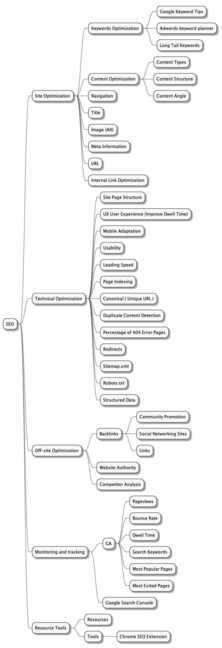SEO Optimizing Techniques

SEO Concepts
- Site Optimization
- Keywords Optimization
- Google Keyword Tips
- Adwords keyword planner
- Long Tail Keywords
- Content Optimization
- Content Types
- Content Structure
- Content Angle
- Navigation
- Title
- Image (Alt)
- Meta Information
- URL
- Internal Link Optimization
- Keywords Optimization
- Technical Optimization
- Site Page Structure
- UX User Experience (Improve Dwell Time)
- Mobile Adaptation
- Usability
- Loading Speed
- Page Indexing
- Canonical (Unique URL)
- Duplicate Content Detection
- Percentage of 404 Error Pages
- Redirects
- Sitemap.xml
- Robots.txt
- Structured Data
- Off-site Optimization
- Backlinks
- Community Promotion
- Social Networking Sites
- Links
- Website Authority
- Competitor Analysis
- Backlinks
- Monitoring and tracking
- GA
- Pageviews
- Bounce Rate
- Dwell Time
- Search Keywords
- Most Popular Pages
- Most Exited Pages
- Google Search Console
- GA
- Resource Tools
- Resources
- Tools
- Chrome SEO Extension
Others
Optimizing websites is an art that few are familiar with. The more the engineer is able to list off the top of their head, the more likely they are to do all of the following naturally as they code instead of having to return later.
(Also, typically a professionally constructed site should score over 75 percent when analyzed by gtmetrix.com, which can also serve as a checklist.)
- Optimize all assets
- Place all assets on a separate, cookie-free domain. Using a CDN is best
- Avoid inline JavaScript and CSS
- Enable gzipping
- Ensure all code is minified
- Defer parsing of JavaScript
- Usesrcsetfor responsive images
- Leverage browser caching
- Reduce DNS lookups
- Avoid duplicate code
- Avoid URL redirects
- Enable HTTP keep-alive
- Serve scaled images
- Use image sprites where appropriate
- Prefer asynchronous resources
- Specify the character set at server level
- Avoid CSS@import
- Specify a cache validator
- Minimize request size
- Avoid bad requests and 404s
- Specify image dimensions
- Reduce cookie size
- Make fewer HTTP requests, i.e., load as few external resources as possible
- Avoid unnecessary images; where possible, use CSS
- Ensure no validation errors with W3C